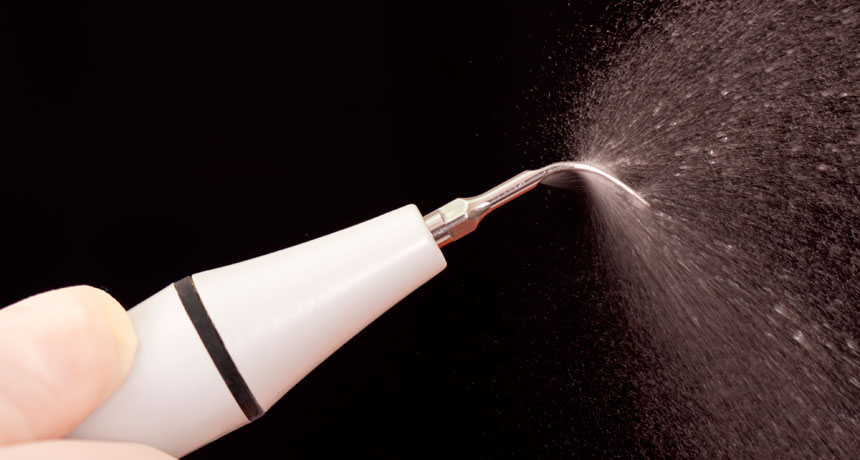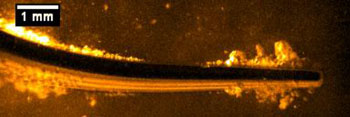Scrubbing bubbles: Secret to ouch-free dental cleanings?
Forces created when bubbles collapse could lead to the development of 'touchless' tooth-cleaning

Many dentists use this tool, an ultrasonic scaler, to clean teeth. As it vibrates, a process called cavitation creates tiny bubbles at the tool’s curve and at its tip.
iStock/Lighthaunter
By Ilima Loomis
People with sensitive teeth often hate visiting the dentist. One reason: Having their teeth cleaned and polished can hurt. Now, scientists have taken a close-up look at the tool that dentists use for that cleaning — and the tiny bubbles it creates. They think their work could lead to a new tool that can clean teeth without ever touching them. It would simply let the bubbles do the scrubbing.
Dentists and hygienists typically clean patients’ teeth with an ultrasonic scaler. The head of this device is a thin, curved metal rod that vibrates very rapidly. Water flows from the tool’s tip so that it won’t get too hot. When held against the side of a tooth, the scaler breaks up hardened plaque. But its vibrating tip can scratch a tooth’s protective enamel surface. It also can damage the surface of the dental implants that hold artificial teeth in place.
WATCH: Ultrasonic scaler in action
Tiny “cavitation” bubbles form around the vibrating tip of a dentist’s ultrasonic scaler. Check out video S2.
“We were looking for a better way to clean teeth that would be more efficient as well as less painful and cause less damage,” says Nina Vyas. She’s part of a group at the University of Birmingham in England. They train scientists to find new or better uses for imaging technologies in biomedicine. While working closely with a dentist who studies ultrasonic scalers, she became interested in looking at how her group might potentially improve the way that dentists treat patients.
But first they needed to understand more about how it worked. So they used high-speed cameras. These recorded what was happening at the scaler’s bend and at its tip. When the scientists played back those recordings, they saw that the vibrations made “clouds” of bubbles through a process known as cavitation (KAV-ih-TAY-shun). Only about the width of a human hair, these bubbles expand and collapse very rapidly. Their collapse creates shock waves that shoot very small jets of water onto the surface being cleaned.
It’s the first time researchers have seen this happening at the tips of ultrasonic scalers, says Vyas. Her team also showed that more powerful vibrations lead to more cavitation. Scalers come with different shaped tips for cleaning different parts of the mouth. The Birmingham scientists showed that different shaped tips affect the size and shape of the bubble cloud that forms.
The researchers described their new findings March 2 in the journal PLOS ONE.
Patrick Schmidlin conducts medical research on dentistry at the University of Zurich in Switzerland. He was not involved with the new study. Researchers have long known that ultrasonic scalers create the tiny bubbles, he notes. But this is the first time, he says, that anyone has measured them as they occur.
What’s next?
Dentists also use ultrasonic scalers to clean around a tooth’s root. Future studies should look at how fluids such as saliva and blood may affect cavitation there, Schmidlin recommends.

Her team is testing that now. “It will help us develop a better instrument,” she says. “A non-touch approach would be a lot less painful for patients who have sensitive teeth.”
Power Words
(for more about Power Words, click here)
biomedical Having to do with medicine and how it interacts with cells or tissues.
cavitation The formation and quick collapse of bubbles in a liquid, caused by mechanical force.
enamel The glossy, hard substance that covers a tooth.
implant A device manufactured to replace a missing biological structure, to support a damaged biological structure, or to enhance an existing biological structure. Examples include artificial hips, knees and teeth; pacemakers; and the insulin pumps used to treat diabetes.
plaque A biofilm, or community of bacterial species, that grows on teeth and other surfaces in the mouth.
scaler (in dentistry) A tool for removing plaque from teeth.
shock waves Tiny regions in a gas or fluid where properties of the host material change dramatically owing to the passage of some object (which could be a plane in air or merely bubbles in water). Across a shock wave, a region’s pressure, temperature and density spike briefly, and almost instantaneously.
ultrasound (adj. ultrasonic) Sounds at frequencies above the range that can be detected by the human ear.
This is one in a series presenting news on invention and innovation, made possible with generous support from the Lemelson Foundation.







